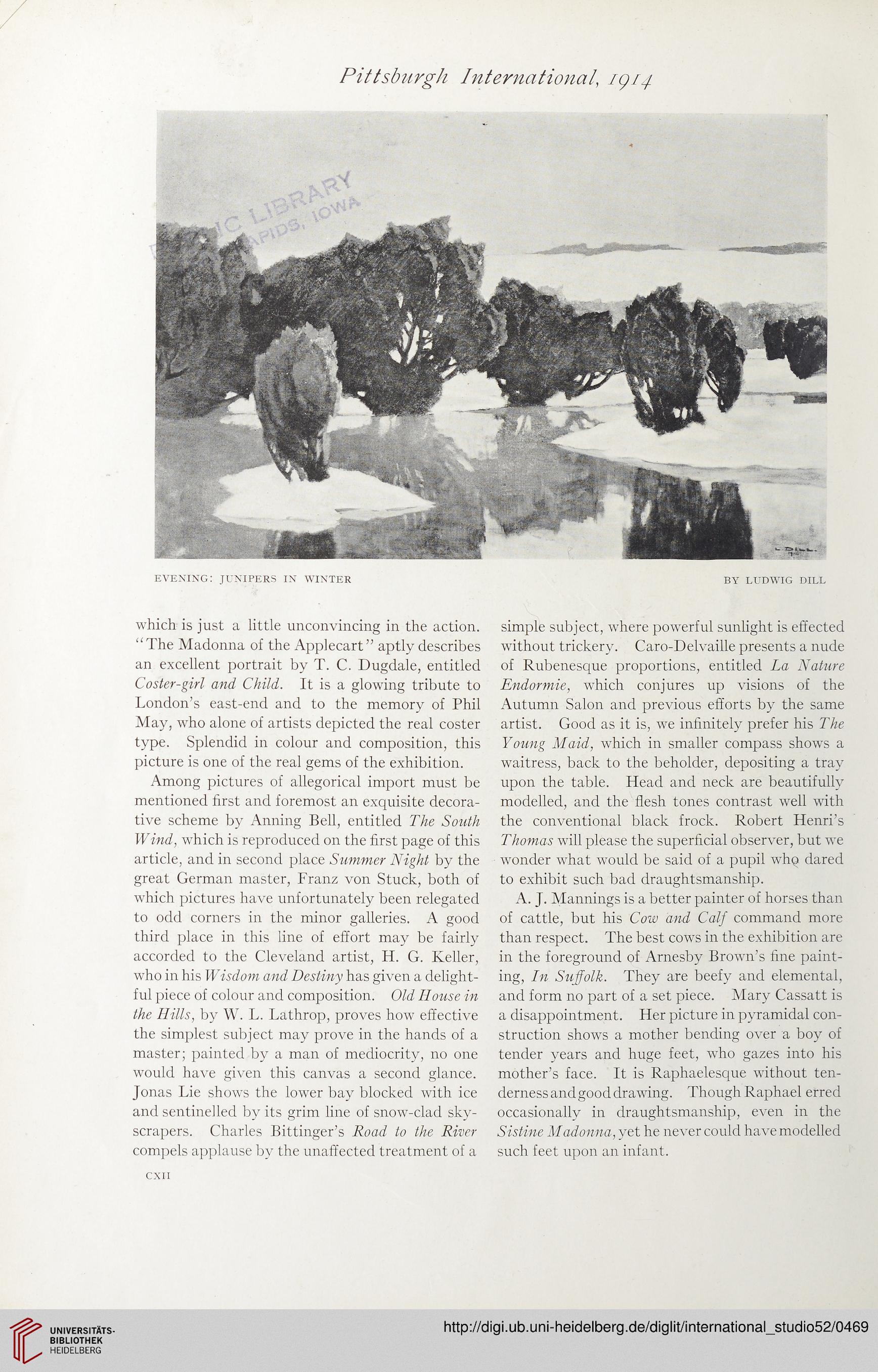Pittsburgh International, 1914
evening: junipers in winter
which is just a little unconvincing in the action.
“The Madonna of the Applecart” aptly describes
an excellent portrait by T. C. Dugdale, entitled
Coster-girl and Child. It is a glowing tribute to
London’s east-end and to the memory of Phil
May, who alone of artists depicted the real coster
type. Splendid in colour and composition, this
picture is one of the real gems of the exhibition.
Among pictures of allegorical import must be
mentioned first and foremost an exquisite decora-
tive scheme by Anning Bell, entitled The South
Wind, which is reproduced on the first page of this
article, and in second place Summer Night by the
great German master, Franz von Stuck, both of
which pictures have unfortunately been relegated
to odd corners in the minor galleries. A good
third place in this line of effort may be fairly
accorded to the Cleveland artist, H. G. Keller,
who in his Wisdom and Destiny has given a delight-
ful piece of colour and composition. Old House in
the Hills, by W. L. Lathrop, proves how effective
the simplest subject may prove in the hands of a
master; painted by a man of mediocrity, no one
would have given this canvas a second glance.
Jonas Lie shows the lower bay blocked with ice
and sentinelled by its grim line of snow-clad sky-
scrapers. Charles Bittinger’s Road to the River
compels applause by the unaffected treatment of a
BY LUDWIG DILL
simple subject, where powerful sunlight is effected
without trickery. Caro-Delvaille presents a nude
of Rubenesque proportions, entitled La Nature
Endormie, which conjures up visions of the
Autumn Salon and previous efforts by the same
artist. Good as it is, we infinitely prefer his The
Young Maid, which in smaller compass shows a
waitress, back to the beholder, depositing a tray
upon the table. Head and neck are beautifully
modelled, and the flesh tones contrast well with
the conventional black frock. Robert Henri’s
Thomas will please the superficial observer, but we
wonder what would be said of a pupil whq dared
to exhibit such bad draughtsmanship.
A. J. Mannings is a better painter of horses than
of cattle, but his Cow and Calf command more
than respect. The best cows in the exhibition are
in the foreground of Arnesby Brown’s fine paint-
ing, In Suffolk. They are beefy and elemental,
and form no part of a set piece. Mary Cassatt is
a disappointment. Her picture in pyramidal con-
struction shows a mother bending over a boy of
tender years and huge feet, who gazes into his
mother’s face. It is Raphaelesque without ten-
derness and good drawing. Though Raphael erred
occasionally in draughtsmanship, even in the
Sistine Madonna, yet he never could have modelled
such feet upon an infant.
CXII
evening: junipers in winter
which is just a little unconvincing in the action.
“The Madonna of the Applecart” aptly describes
an excellent portrait by T. C. Dugdale, entitled
Coster-girl and Child. It is a glowing tribute to
London’s east-end and to the memory of Phil
May, who alone of artists depicted the real coster
type. Splendid in colour and composition, this
picture is one of the real gems of the exhibition.
Among pictures of allegorical import must be
mentioned first and foremost an exquisite decora-
tive scheme by Anning Bell, entitled The South
Wind, which is reproduced on the first page of this
article, and in second place Summer Night by the
great German master, Franz von Stuck, both of
which pictures have unfortunately been relegated
to odd corners in the minor galleries. A good
third place in this line of effort may be fairly
accorded to the Cleveland artist, H. G. Keller,
who in his Wisdom and Destiny has given a delight-
ful piece of colour and composition. Old House in
the Hills, by W. L. Lathrop, proves how effective
the simplest subject may prove in the hands of a
master; painted by a man of mediocrity, no one
would have given this canvas a second glance.
Jonas Lie shows the lower bay blocked with ice
and sentinelled by its grim line of snow-clad sky-
scrapers. Charles Bittinger’s Road to the River
compels applause by the unaffected treatment of a
BY LUDWIG DILL
simple subject, where powerful sunlight is effected
without trickery. Caro-Delvaille presents a nude
of Rubenesque proportions, entitled La Nature
Endormie, which conjures up visions of the
Autumn Salon and previous efforts by the same
artist. Good as it is, we infinitely prefer his The
Young Maid, which in smaller compass shows a
waitress, back to the beholder, depositing a tray
upon the table. Head and neck are beautifully
modelled, and the flesh tones contrast well with
the conventional black frock. Robert Henri’s
Thomas will please the superficial observer, but we
wonder what would be said of a pupil whq dared
to exhibit such bad draughtsmanship.
A. J. Mannings is a better painter of horses than
of cattle, but his Cow and Calf command more
than respect. The best cows in the exhibition are
in the foreground of Arnesby Brown’s fine paint-
ing, In Suffolk. They are beefy and elemental,
and form no part of a set piece. Mary Cassatt is
a disappointment. Her picture in pyramidal con-
struction shows a mother bending over a boy of
tender years and huge feet, who gazes into his
mother’s face. It is Raphaelesque without ten-
derness and good drawing. Though Raphael erred
occasionally in draughtsmanship, even in the
Sistine Madonna, yet he never could have modelled
such feet upon an infant.
CXII




